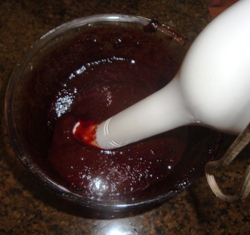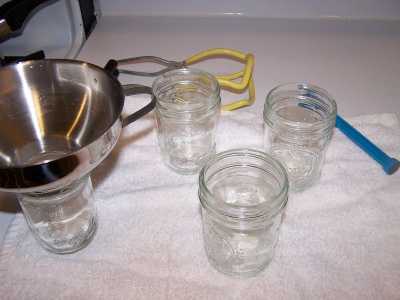
Looking for How to Make Cherry Butter - Easily! With Step-by-step Directions, Photos, Ingredients, Recipe and Costs in 2025? Scroll down this page and follow the links. And if you bring home some fruit or vegetables and want to can, freeze, make jam, salsa or pickles, see this page for simple, reliable, illustrated canning, freezing or preserving directions. There are plenty of other related resources, click on the resources dropdown above. If you are having a hard time finding canning lids, I've used these, and they're a great price & ship in 2 days.
If you have questions or feedback, please let me know! There are affiliate links on this page. Read our disclosure policy to learn more.
How to Make Cherry Butter - Easily! With Step-by-step Directions, Photos, Ingredients, Recipe and Costs
Yield: 5 to 7 pint jars
Click here for a PDF print version
You think making and canning your own cherry butter is
difficult? Well, it used to be! Until crock pots and slow cookers
came along!
Now, it's easy! Here's how to do it, complete instructions in easy steps and completely illustrated. The cherry butter will taste MUCH better than anything you've ever had from a store. If you like apple butter, you will love cherry butter!
You can make with sugar, with no sugar and no sweetener, or with another sweetener (all described below)
Prepared this way, the jars have a shelf life of 18 months to 2 years, and require no special attention. A side benefit is that your house will smell wonderful while it is cooking - much better than potpourri! You can also skip the last canning steps, and just store it in your refrigerator (2 or 3 months) or freezer (indefinitely).
Ingredients
- 4 or 5 quarts of pitted Cherries, fresh or frozen (See step 1 for more
details)
You can also use cherry juice (fresh, frozen or bottled) - 2 tablespoons of ground cinnamon
- 1 teaspoon ground cloves
- 1/2 teaspoon of allspice
- 1 tablespoon of vanilla extract
- 4 cups your choice of sweetener: sugar, Stevia (in a prepared form like Truvia, it measures same as sugar; if you use another form, you will need do your own conversion) - or Splenda, if you prefer, , honey or frozen concentrated grape juice. (like it or not, sugar yields the best results)
Equipment
- Jar grabber (to pick up the hot jars)
- Lid lifter (I like the lid rack that holds 12 lids or you can pull them out one at a time with the lid-lifter that has a magnet from the almost-boiling water where you sanitize them. ($4 at Target, other big box stores, and often grocery stores; and available online - see this page)
- Jar funnel ($5 at Target, other big box stores, and often grocery stores; and available online - see this page)
- 1 Crock pot (slow cooker) 5 to 6 quart size (if your crockpot is smaller, just reduce the ingredients proportionately)
- Large spoons and ladles,
- 1 Water Bath Canner (a huge pot to sanitize the jars of cherry butter after filling (about $30 to $35 at mall kitchen stores, sometimes at big box stores and grocery stores.))
- Canning jars (often called Ball jars, Mason jars or Kerr jars) (Grocery stores, like Publix, Kroger, Safeway carry them, as do some big box stores - now about $12 per dozen quart jars (up 50% in 2 years!) including the lids and rings)Cherry pitter: without one of these, it's pretty hard to remove the pits from a fresh cherry.
- BEST PITTERS AVAILABLE: Leifheit
Pitter and the Norpro
Deluxe Cherry Pitter.
These things are amazing; easy fast and reliable. The Norpro can handle larger volumes of cherries reliably! I can pit a cherry per second. The Leifeit is even better, as it is larger!
Comments from a visitor on July 1, 2010: "I wanted to let you know about the Norpro Deluxe Cherry Stoner/Pitter. These things are GREAT!!! They pit cherries reliably and remarkably fast! Just tell your readers to NOT lose the orange inserts (they may be other colors now) that come with the cherry pitter. They're definitely necessary to actually pit the cherries."
See here for related tools, equipment, supplies on Amazon
See here for related tools, equipment, supplies on Amazon
See here for related tools, equipment, supplies on Amazon
See these videos about setting up and using the Norpro Deluxe Cherry Pitter, to see just how easy and fast it is.
Cherry Butter Recipe and Directions
Step 1 - Pick the cherries! (or buy them already picked)
It's fun to go pick your own and you can obviously get better quality ones!
As mentioned in the Ingredients section; you may use frozen
cherries (those without syrup or added sugar); which is especially useful if you want to make some jam in December to give away at Christmas!
If you are starting with cherry juice, skip to step 6.How much fruit?
You will need about 6 quarts of finely chopped, pitted cherries (which is about 18 pounds or 12 quart boxes of fresh whole cherries). You can use sweet or sour cherries, but obviously, you will need to add more sugar with sour cherries to overcome the sourness!
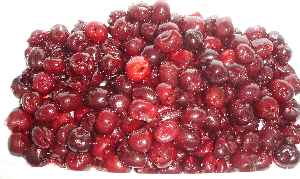 Jam can ONLY be made in rather small batches - about
4 cups at a time - like the directions on the pectin say, DO NOT increase the
recipes or the jam won't "set" (jell, thicken). (WHY? Alton Brown on the
Food Channel says pectin can overcook easily and lose its thickening properties.
It is easier and faster to get an even heat distribution in smaller batches.
Jam can ONLY be made in rather small batches - about
4 cups at a time - like the directions on the pectin say, DO NOT increase the
recipes or the jam won't "set" (jell, thicken). (WHY? Alton Brown on the
Food Channel says pectin can overcook easily and lose its thickening properties.
It is easier and faster to get an even heat distribution in smaller batches.
Step 2
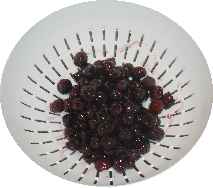 -Wash the
cherries!
-Wash the
cherries!
I'm sure you can figure out how to wash the fruit in plain cold water. As with other fruit, also pick out any stems and leaves.
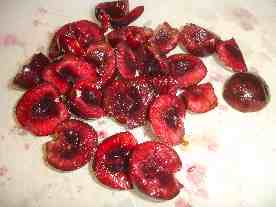 With
cherries you must remove the pits. There are inexpensive cherry pitters that
work fine for occasional use, or larger more sophisticated pitters if you're
going to be doing a lot. BUT we're going to use an easier
method - we will cook the cherries until they are soft, and then use a food mill
or strainer to separate the pulp from the pits. If you have a food mill or other
strainer, or you are using frozen pitted cherries, skip to step 3.
With
cherries you must remove the pits. There are inexpensive cherry pitters that
work fine for occasional use, or larger more sophisticated pitters if you're
going to be doing a lot. BUT we're going to use an easier
method - we will cook the cherries until they are soft, and then use a food mill
or strainer to separate the pulp from the pits. If you have a food mill or other
strainer, or you are using frozen pitted cherries, skip to step 3.
If you don't have a food mill or strainer, you will need to do it manually. Here's how:
Pit the fresh cherries, and keep them in cold water with 1/4 lemon juice add (to
prevent browning)
.
A cherry pitter is inexpensive and easy to use, once you learn the trick. The goal is to push down so the metal stem holds the pit down against the opening in the bottom of the cup. The pits will not go through the hole; it is just to help trap them. then releasing your grip, the cherry rides up on the metal stem, while the pit remains trapped in the cup, stuck in the hole. Then just push the cherry off and use your thumb on the underside of the cup, to push the pit back out.
See here for related tools, equipment, supplies on Amazon
BEST PITTERS AVAILABLE: Leifheit
Pitter and the Norpro
Deluxe Cherry Pitter.
These things are amazing;
easy fast and reliable. The Norpro can handle
larger volumes of cherries reliably! I can pit a cherry per
second. The Leifeit is even better, as it is larger!
Comments from a visitor on July 1, 2010: "I wanted to let you know about the Norpro Deluxe Cherry Stoner/Pitter.
These things are GREAT!!! They pit cherries reliably and remarkably fast!
Just tell your readers to NOT lose the orange inserts (they may be other colors
now) that come with the cherry pitter. They're definitely necessary to
actually pit the cherries."
See here for related tools, equipment, supplies on Amazon
See here for related tools, equipment, supplies on Amazon
See these videos about setting up and using the Norpro Deluxe Cherry Pitter, to see just how easy and fast it is.
Now, if you absolutely can't get hold of a cherry pitter... I think you could heat the cherries to a boil, then run them through a foley food mill or other strainer, to separate the pits from the cherries. I haven't tried it, but that ought to be easier than manually pitting cherries with a knife.
Step 3 - Fill the crockpot with the cherries
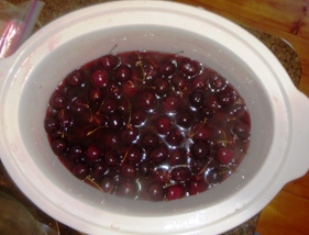 We will use the crockpot to soften up the cherries so we can pass the pulp through a
strainer to remove the pits and any stems.
We will use the crockpot to soften up the cherries so we can pass the pulp through a
strainer to remove the pits and any stems.
I fill the crock pot and add 1 cup of apple juice (or cherry juice or water, as you prefer and have available) per pound of cherries. So, for our 6 lb batch, that's 6 cups of liquid. It may seem like a lot of liquid, but the cherries will absorb a fair amount of it.
I turn it on high and let it go for an hour, then turn it down to low for a couple more hours.
Step 4 - Let cool until it it warm, not hot
Why let it cool? It's pretty hard to pick out the pits while you are burning your fingers, that's why! So I let it cool just enough that I hand reach in and pick out pits. If you started with pitted cherries, it doesn't matter; you can skip to step 5 and strain while it is hot.
Step 5 - Strain the cooked, softened cherries
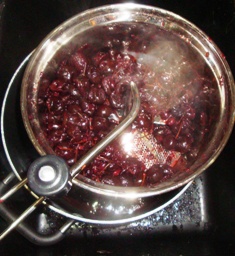
A cylindrical food strainer, like the Roma or Vittorio work best. A Foley food mill will work, but it tends to get the pits caught under the blade, so you have to stop frequently to remove pits; but it does a great job and take less time than manually pitting the cherries before cooking.
The Foley food mills (at right) cost about $30.
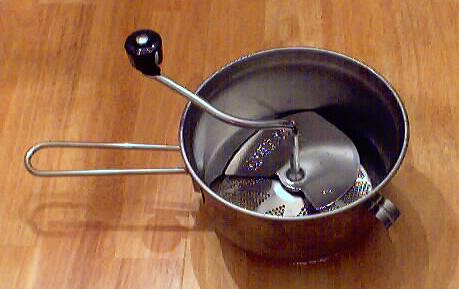
See here for related tools, equipment, supplies on Amazon
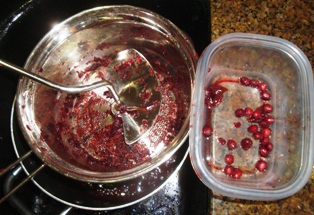
Step
6 - Re-fill
the crock pot with the strained cherries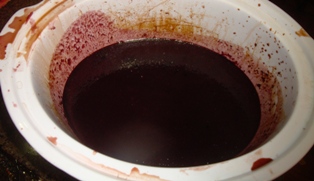
After you have strained out the pits and steps, the strained cherries will be pretty smooth - like chunky applesauce. Pour it all into the crock pot and set it on low. You should always start by setting the crock pot on low or medium heat. I would recommend starting with low heat because you do not want to risk burning it! If it doesn't get hot enough to reduce in 12 hours, bump the setting up to the next position, and watch more carefully, in case that turns out to be too hot! You want to evaporate off enough water to yield the consistency that you like. I find that final volume should be able 1/3 the starting volume to get a nice, thick cherry butter.
Step 7 -Add the sweetener and optional spices
If you started with a full crockpot and now it is about half full, you will add about 4 cups of sweetener. But the key is to taste it. It doesn't need to be sweeter that you like. 4 cups of sugar, Stevia (in a prepared form like Truvia, it measures same as sugar; if you use another form, you will need do your own conversion) - or Splenda, if you prefer, (for diabetics), Honey or other sweetener is just a guideline. Start low and just add enough to suit your tastes.
You can skip the sweeteners entirely, too; but it loses a lot of the richness of flavor, in my opinion.
Now is the time to add spices, if you like them. Taste the cherry butter with just the sweetener in it. It should have a rich dark cherry flavor. Take a spoonful out and sprinkle just a few specks of cinnamon and even less of cloves on it - see how you like that. The spices add a different dimension to it. It tastes great with and without spices. The spices give it the complexity of a fruit butter, but many people like the plainer taste of the fruit alone.
If you do add spice, don't add to much that you overpower the cherry flavor. This is plenty:
- 1 teaspoon of ground cinnamon
- 1/4 teaspoon ground cloves
- 1 Tablespoon vanilla extract
In place of sugar, you can use an equivalent amount Splenda (or about 1/3 that if you use Stevia, which is my preference) (sucralose) OR 1 twelve ounce can of frozen concentrated fruit juice (preferably a neutral juice, like grape or apple).
Step 8 - Cook down the Cherry butter
Set
the crock pot on low
heat.
Cover it loosely or use a large pot splatter-guard. It can spatter as it boils slowly, so I also cover nearby surfaces with towels. You don't want to seal it tightly because you want the steam to escape so it can reduce in volume and thicken. A visitor suggests, take a couple of butter knives, and lay them across the top of the crock pot. They are parallel and located about 2/3 of the way out from the center. Then put the lid on these supports, leaving it "covering" the pot and keeping the splatters under control, but, leaving a good gap for steam to escape. I just made a batch and tried this approach, but I used a pair of wooden chopsticks or bamboo kebab skewers - they worked great!
Leave it to cook for several hours. How long depends on the size and power of your crockpot, and how thick you like it, If you want to stir it occasionally, that's fine but not necessary. .
Step 9 - Wash the jars and lids, get the water boiling in the canner
 Now's a good time to get the
the water bath canner boiling and get the jars ready, so you won't be rushed later.
The dishwasher is fine for the jars; especially if it has a "sanitize" cycle, the water bath processing will
sanitize them as well as the contents! If you don't have a dishwasher with a sanitize cycle, you can wash the containers in hot, soapy water and rinse, then
sanitize the jars by boiling them 10 minutes, and keep the jars in hot
water until they are used.
Now's a good time to get the
the water bath canner boiling and get the jars ready, so you won't be rushed later.
The dishwasher is fine for the jars; especially if it has a "sanitize" cycle, the water bath processing will
sanitize them as well as the contents! If you don't have a dishwasher with a sanitize cycle, you can wash the containers in hot, soapy water and rinse, then
sanitize the jars by boiling them 10 minutes, and keep the jars in hot
water until they are used.
Leave the jars in the dishwasher on "heated dry" until you are ready to use them. Keeping them hot will prevent the jars from breaking when you fill them with the hot cherry butter.
Put the lids into a pan of hot, but not quite boiling water (that's what the manufacturer's recommend) for 10 minutes, and use the magnetic "lid lifter wand" to pull them out.
Step 10 - Blend the cherry butter (optional)
You want a smooth, creamy texture, right?
The easiest way is to use a hand-held drink blender. It does a great job
of making it smooth. You can also put it into a regular blender, but
if you are going to do that, you might want to blend the cooked cherry sauce
before you put it in the crock pot (it will be much thicker afterwards and
won't move in a regular blender). Another visitor says running it through
a food mill with a fine screen or through a sieve works, too.
Tips:
- Too thick? if the cherry butter cooks down too much or is too thick for your liking, just add a little bit of apple juice and blend it in.
- Not thick enough? Just let it cook some more, with the lid off so the steam can escape!
Step 11 - Fill and seal the jars
If the crockpot isn't keeping the cherry butter boiling hot, you will need to briefly return the butter to the stove to get it hotter. It varies from crockpot to crockpot. I find that if I set my crockpot on high for the 15 minutes before I fill the jars and stir frequently, it gets it boiling.
Fill the jars to within 1/4-inch of the top, wipe any spilled cherry butter of the
top, seat the lid and tighten the ring around them.
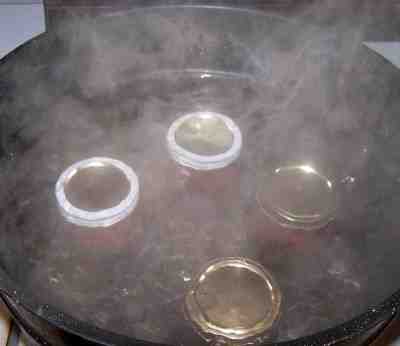
Step 12 - Process the jars
Process means put them in the canner and keep them covered with at least 1 inch of water and boiling. if you are at sea level (up to 1,000 ft) boil pint jars for 15 minutes and quart jars for 20 min. If you are at an altitude of 1,000 feet or more, see the chart below. There isn't a USDA or Ball recipe for cherry butter, but their directions for cherry jam and cherry preserves are almost identical; this is just cooked down more and doesn't require pectin, so the processing times borrowed from those recipes shoul dbe plenty safe;.
|
Recommended process time for Cherry Butter in a boiling-water canner. |
|||
|
Jar Size |
Process Time at Altitudes of |
||
|
|
0 - 1,000 ft |
1,001 - 6,000 ft |
Above 6,000 ft |
|
Half-pints or Pints |
15 min |
20 |
25 |
|
Quarts |
20 |
25 |
25 |
Step 13 - Done
Lift the jars out of the water and let them cool without touching or
bumping them in a draft-free place (usually takes overnight) You can then remove the rings if you like, but if you leave them on, at least loosen them quite a bit, so they don't rust in place due to trapped moisture. Once the jars are cool, you can check that they are sealed verifying that the lid has been sucked down. Just press in the center, gently, with your finger. If it pops up and down (often making a popping sound), it is not sealed. If you put the jar in the refrigerator right away, you can still use it. Some people replace the lid and reprocess the jar, then that's a bit iffy. If you heat the contents back up, re-jar them (with a new lid) and the full time in the canner, it's usually ok.
Commonly Asked Cherry Butter Questions (FAQs)
Comments
Comments from a visitor on August 14, 2009: "I am new at this. -A few years ago at a Cherry Festival, I bought Cherry Butter and fell in love with it. After ALOT of searching, couldn't really find a good recipe. So I followed your Crock Pot Peach butter recipe- but used cherries. YES! That was it.
Canning Books, Supplies and Accessories
These are my favorite essential canning tools, books and supplies. I've been using many of these for over 50 years of canning! The ones below on this page are just the sampling of. my preferred tools. but you can find much more detailed and extensive selections on the pages that are linked below.
- Strainers, pit removers, seed-skin-stem removers, jelly strainers, etc. All types, makes and prices (from $19 to $350)
- Selecting a KitchenAid mixer and attachments for home canning
- Vacuum Foodsealers for freezing, dried foods, and refrigerated foods - the FoodSaver line
- Cherry pitters reviews, prices and ordering
- Steam Juicers
- Food dehydrators - easy and fast to dry your own fruits, veggies, sun-dried tomatoes, etc.
The All New Ball Book Of Canning And Preserving: Over 350 of the Best Canned, Jammed, Pickled, and Preserved Recipes Paperback
This is THE book on canning! My grandmother used this book when I was a child.; It tells you in simple instructions how to can almost anything; complete with recipes for jam, jellies, pickles, sauces, canning vegetables, meats, etc.
If it can be canned, this book likely tells you how! Click on the link below for more information and / or to buy (no obligation to buy)The New Ball Blue Book of Canning and Preserving
Canning and Preserving for Dummies by Karen Ward
This is another popular canning book. Click here for more information, reviews, prices for Canning and Preserving For Dummies
Of course, you do not need to buy ANY canning book as I have about 500 canning, freezing, dehydrating and more recipes all online for free, just see Easy Home Canning Directions.
Home Canning Kits
See here for related tools, equipment, supplies on Amazon See here for related tools, equipment, supplies on Amazon
I have several canners, and my favorite is the stainless steel one at right. It is easy to clean and seems like it will last forever. Mine is 10 years old and looks like new.
The black ones are the same type of standard canner that my grandmother used to make everything from applesauce to jams and jellies to tomato and spaghetti sauce.
This complete kit includes everything you need and lasts for years: the canner, jar rack, Jar grabber tongs, lid lifting wand, a plastic funnel, labels, bubble freer, It's much cheaper than buying the items separately. It's only missing the bible of canning, the Ball Blue Book.
You will never need anything else except jars & lids (and the jars are reusable)!
The complete list of canners is on these pages:
- Water bath canners - Good for acidic foods, like applesauce, pickles, salsa, jams, jellies, most fruits
- Pressure canners - needed for low and non-acidic foods, like canned vegetables (corn, green beans, etc), and meats
- Canners for glass top stoves if you have a glass or ceramic stove
- Canners for induction stovetops
Pressure Canners
If you plan on canning non-acidic foods and low acid foods that are not pickled - this means: meats, seafood, soups, green beans corn, most vegetables, etc., then you ABSOLUTELY must use a Pressure Canner.
Of course, you can use a pressure canner as a water bath canner as well - just don't seal it up, so it does not pressurize. This means a Pressure Canner is a 2-in-1 device. With it, you can can almost ANYTHING.
There are also other supplies, accessories, tools and more canners, of different styles, makes and prices, click here!
Basic Canning Accessories
From left to right:
- Jar lifting tongs to pick up hot jars
- Lid lifter - to remove lids from the pot of boiling water (sterilizing )
- Lids- disposable - you may only use them once
- Ring - holds the lids on the jar until after the jars cool - then you remove them, save them and reuse them
- Canning Jar funnel - to fill the jars
Strainers
These are very useful for making sauces like applesauce, tomato sauce, spaghetti sauce, jellies, etc. Below are my favorites. The complete list is on these pages:
- Strainers, pit removers, seed-skin-stem removers, jelly strainers, etc. All types, makes and prices (from $19 to $350)
- Selecting a KitchenAid mixer and attachments for home canning
Inexpensive Old School Strainers: hand cranked Foley Food Mills
- The hand-cranked Foley food mill (see this page or clock the ad box) has been used for well over 100 years in homes all over America (and variants around the world). It is effective and inexpensive, and ideal for small batches. However, if you need to make many quarts, you will sure end up with tunnel carpel syndrome or some other repetitive strain injury.
Norpro 1951 Manual Food Strainer and other brand stariners, with optional motors; (almost identical to Victorio V250, Villaware and Roma models, all discontinued)
This is The next step up from the Foley food mill. First, it's far more ergonomic, and its handle is easier to use. Next, it works in continuous mode rather than batch mode. So you can do much larger volumes easily. Finally, It has an optional motor, so you can. remove the manual labor. It also offers many different size strainers to use for different types of berries, vegetables and fruit.
See the seller's website for more information, features, pricing and user reviews!
- A Johnny, Weston or Oxo strainer (about $60 - $100, see further down the page) or
- This trainer is. simply a more upscale and improved version of the one above.
- See this page for more information, reviews, descriptions of other strainers and supplies or to order!
KitchenAid - Best Large Volume Strainers
If you're going to do large volumes of fruit or vegetables , or do it year after year, then. you really should think about getting a higher end kitchen. utility device. Kitchen aids are the cream of the crop. Once you buy one of these, you keep at the rest of your life and it gets handed down to the next generation. . My sister is using one she inherited from my mother 25 years ago, who got it in the 1940s as a wedding gift. So, although the initial cost is high, they literally last for many lifetime. So the cost on an annual basis is pretty trivial, especially when you consider the cost of therapy and treatment for. the repetitive strain injuries you will get from manual cranking day after day. Add to that of course the cost of therapy for the emotional injuries you'll get from going insane, standing there hand cranking something for hours.
KitchenAid's with a sieve/grinder (with the attachments, costs about $400, but it lasts a lifetime and is fast and easy to use - I can make 100 quart jars of applesauce per day with one of these).
FREE Illustrated Canning, Freezing, Jam Instructions and Recipes
Don't spend money on books. that you don't need to. Almost everything you can find in some book sold online or in a store is on my website here for free. Start with theEasy Home Canning Directions below. That is a master list of canning directions which are all based upon the Ball Bblue book, the National Center for Home Food Preservation and other reputable lab tested recipes. Almost every recipe I present in addition to being lab tested com. is in a step by step format with photos for each step and complete. explanations. that tell you how to do it, where to get the supplies and pretty much everything you need to know. In addition, there almost always in a PDF format so you can print them out and use them while you cook.
[ Easy Home Canning Directions]
[FAQs - Answers to common questions and problems]
[Recommended books about home canning, jam making, drying and preserving!]
Looking for canning equipment and supplies?
Water bath canner with a jar rack
Pressure canners for gas, electric and induction stoves: Presto 23Qt or T-fal 22Qt
Canning scoop (this one is PERFECT)
Ball Blue book (most recent version)
Jars: 8oz canning jars for jams
Find Other types of farms:
Farm markets and roadside stands
Road trips and camping resources
Local Honey, apiaries, beekeepers
Consumer fraud and scams information
Home canning supplies at the best prices on the internet!
Maple Syrup Farms, sugarworks, maple syrup festivals
Environmental information and resources
Farms For Your Event for birthday parties, weddings, receptions, business meetings, retreats, etc.
Festivals - local fruit and vegetable festivals
Get the
most recent version of
the Ball Blue Book
With this Presto 23 quart pressure canner and pressure cooker, you can "can" everything, fruits, vegetables, jams, jellies, salsa, applesauce, pickles, even meats, soups, stews. Model 01781

You can make jams, jellies, can fruit, applesauce, salsa and pickles with water bath canners, like this Granite Ware 12-Piece Canner Kit, Jar Rack, Blancher, Colander and 5 piece Canning Tool Set

